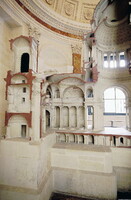| dc.coverage.spatial | Site: Paris, Île-de-France, France | en_US |
| dc.coverage.temporal | 1755-1837 (inclusive) | en_US |
| dc.creator | Soufflot, Jacques Germain | en_US |
| dc.creator | Quatremère de Quincy, Antoine Chrysosthôme | en_US |
| dc.date | 1755-1837 | en_US |
| dc.date.accessioned | 2013-03-14T14:39:55Z | |
| dc.date.available | 2013-03-14T14:39:55Z | |
| dc.date.issued | 1755-1837 | en_US |
| dc.identifier | 199554 | en_US |
| dc.identifier.other | archrefid: 1297 | en_US |
| dc.identifier.uri | http://hdl.handle.net/1721.3/107316 | |
| dc.description | View of the cut-away model, with view into the drum and dome; Early in 1755 Soufflot was appointed to provide plans for Ste Geneviève, the new church promised by Louis XV to house the reliquary of the city's patron saint. A collection of drawings (Paris, Bib. N.) and Claude Boulleau's engraving of 1764 show the building in its 'ideal' state in that year. Built partly over a crypt, where, for the first time, Soufflot used the Doric order of Paestum, it owes its grandeur to his use of the same colossal Corinthian order both inside and out. A heavy pediment emphasizes the dignity of the main entrance; this dominates the vast esplanade planned around the church. From 1791, following a Revolutionary decree, the church was altered into the Panthéon des Grands Hommes. Antoine Quatremère de Quincy had the buttresses demolished and, more crucially, the lower windows blocked up; this radically altered the lighting effects Soufflot had sought to achieve. Having removed the religious sculpture, Quatremère supplied a new programme for decorating the pediments (finally executed by David d'Angers in 1837). [Among those buried in its necropolis are Toussaint Louverture, Voltaire, Rousseau, Marat, Victor Hugo, Émile Zola, Jean Moulin, Marie Sklodowska-Curie, Louis Braille, Jean Jaurès and Soufflot, its architect.] Source: Grove Art Online; http://www.groveart.com/ (accessed 1/25/2008) | en_US |
| dc.rights | © Scott Gilchrist, Archivision, Inc. | en_US |
| dc.subject | architectural exteriors | en_US |
| dc.subject | death or burial | en_US |
| dc.subject | rulers and leaders | en_US |
| dc.subject | Neoclassical | en_US |
| dc.title | Panthéon des Grands Hommes | en_US |
| dc.title.alternative | Église Sainte-Geneviève | en_US |
| dc.title.alternative | Panthéon | en_US |
| dc.type | image | en_US |
| dc.rights.access | Licensed for educational and research use by the MIT community only | en_US |
| dc.identifier.vendorcode | 1A1-SJG-P-BB1 | en_US |
| vra.culturalContext | French | en_US |
| vra.technique | construction (assembling) | en_US |
| vra.worktype | church | en_US |
| vra.worktype | mausoleum | en_US |
| dc.contributor.display | Antoine Chrysosthôme Quatremère de Quincy (French architect, 1755-1849); Jacques Germain Soufflot (French architect, 1713-1780) | en_US |


